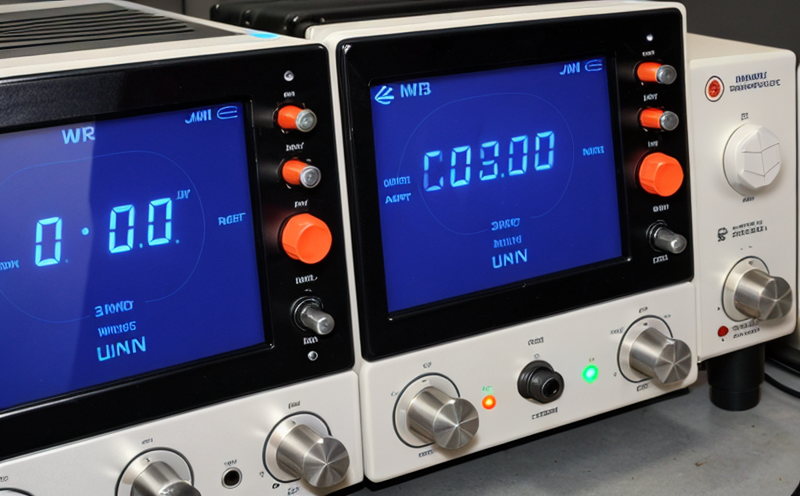EN 300 328 Wi-Fi 2.4 GHz Communication Compliance Testing
The European standard EN 300 328 provides a framework for ensuring that devices operating in the 2.4 GHz frequency band comply with the necessary technical and regulatory requirements set forth by the European Union. This testing is crucial for manufacturers to ensure their products meet strict standards, thereby avoiding potential legal issues and market entry barriers.
The standard covers a wide range of aspects including electromagnetic compatibility (EMC), safety, interoperability, and performance tests. Compliance with EN 300 328 ensures that devices like Wi-Fi routers, smart home accessories, IoT sensors, and other communication gadgets can operate reliably within the specified frequency band without causing interference to or being affected by other devices.
One of the key aspects of this testing is the evaluation of the electromagnetic compatibility (EMC) of a device. This includes ensuring that the device does not emit excessive levels of radiofrequency radiation and that it can coexist with other wireless devices in the vicinity without causing harmful interference. The standard also mandates tests to assess the robustness of the device against various types of interference, including conducted and radiated emissions.
Performance testing under EN 300 328 is equally important as it ensures that a device operates efficiently within its intended environment. This involves assessing factors such as signal strength, data transmission rates, and latency. These tests are conducted in controlled environments that mimic real-world conditions to provide accurate results.
The standard also includes safety criteria which are essential for protecting users from potential hazards associated with the use of wireless devices. This encompasses physical safety measures like ensuring that device components do not overheat or emit harmful levels of radiation, as well as functional safety considerations such as preventing accidental operation leading to injury or damage.
Interoperability testing is another critical component of EN 300 328 compliance. It ensures that devices from different manufacturers can communicate effectively with each other without any issues. This is particularly important in the context of smart home and IoT ecosystems where multiple devices need to work seamlessly together.
The process of preparing a device for testing under EN 300 328 involves several steps. Initially, detailed documentation about the product's specifications and intended use must be provided. Then, the actual hardware is subjected to various types of tests in controlled environments designed to replicate real-world scenarios. Finally, the results are analyzed to determine whether they meet all specified criteria outlined in the standard.
For quality managers and compliance officers responsible for ensuring regulatory adherence, EN 300 328 provides a comprehensive set of guidelines that guide them through the necessary steps required for successful product launches into European markets. For R&D engineers focused on developing innovative solutions within this frequency band, compliance testing serves as an indispensable tool in refining their designs until they meet all relevant requirements.
For procurement professionals seeking reliable suppliers who adhere to global standards like EN 300 328, participating in such tests demonstrates a company's commitment not only to quality but also to responsible business practices. By adhering strictly to these standards, manufacturers can build trust among consumers and stakeholders alike while ensuring long-term success in the competitive European market.
Environmental and Sustainability Contributions:
By promoting interoperability between different brands of wireless devices, EN 300 328 helps reduce electronic waste by extending the lifespan of products through increased compatibility and reduced need for replacement.
The standard encourages efficient use of resources by mandating robust performance tests that ensure devices operate optimally within their intended environments. This minimizes energy consumption and reduces environmental impact.
Competitive Advantage and Market Impact:
Achieving EN 300 328 compliance establishes a strong brand presence in the European market, opening doors to new business opportunities and enhancing overall reputation among consumers.
Compliance signals reliability and quality assurance to potential clients, which is particularly important for companies operating in sectors heavily reliant on wireless technology such as healthcare and automotive industries.
Industry Applications
The application of EN 300 328 compliance testing extends beyond just consumer electronics. It plays a pivotal role across various sectors where reliable communication is essential:
In the healthcare sector, devices like medical monitoring systems and remote patient management solutions must adhere to strict standards for safety and performance.
The automotive industry also benefits significantly from ensuring that onboard infotainment systems and telematics services meet EN 300 328 requirements. This ensures passenger safety and enhances driving experiences.
Smart home devices such as smart thermostats, security cameras, and voice assistants all rely on seamless wireless connectivity to function properly. Compliance testing helps manufacturers ensure their products integrate smoothly into existing networks without causing interference or degradation of service.
In each case, compliance with EN 300 328 not only ensures regulatory adherence but also enhances product performance and reliability, ultimately leading to better user experiences.





